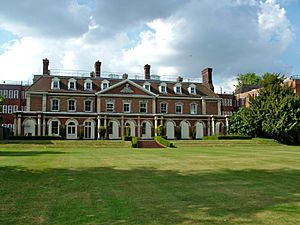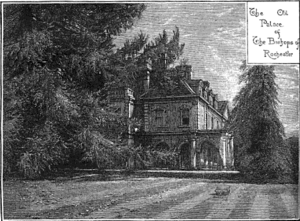Bromley Palace facts for kids
Quick facts for kids Bromley Palace |
|
|---|---|

Bromley Palace
|
|
| Location | Bromley |
| Built | 1776 |
|
Listed Building – Grade II
|
|
| Designated | 10 January 1955 |
| Reference no. | 1281268 |
| Lua error in Module:Location_map at line 420: attempt to index field 'wikibase' (a nil value). | |
Bromley Palace, also known as the Bishop's Palace, is a large historic house in Bromley, London. For many centuries, from the 1100s until 1845, it was the home of the Bishops of Rochester. Today, the building is part of the Bromley Civic Centre. It is recognized as a Grade II listed building, meaning it is an important historical site.
Contents
History of Bromley Palace
The story of Bromley Palace begins a very long time ago. In the 700s, King Æthelbert II of Kent gave a large piece of land in Bromley to Eardwulf, who was the Bishop of Rochester. This land became known as the Manor of Bromley.
Over the years, the land was sometimes given away or taken back. In 862, King Æthelberht III of Wessex and Kent gave land in Bromley to one of his officials. Later, in 967, King Edgar I of England gave land back to Bishop Ælfstan.
There were also disagreements about who owned the land. In 987, King Ethelred II took the land from the Bishop of Rochester. But he later returned it in 998. After the Normans conquered England in 1066, another powerful figure, Bishop Odo of Bayeux, tried to take the land. However, Archbishop Lanfranc stepped in to make sure the land was returned to the church.
The First Manor House
People believe that the first manor house was built on this site around the year 1100. It was probably surrounded by a moat, which is a deep, wide ditch, often filled with water, for protection. Records show that this first house became quite old and run-down by 1184.
Because of this, the next bishop, Gilbert de Glanville, decided to have the manor house rebuilt. He wanted it to be more comfortable and suitable.
A Place of Pilgrimage
The grounds of the palace were special because they had a Holy Well and a small chapel called an Oratory. These were dedicated to Saint Blaise. For many centuries, people would travel here as a pilgrimage to visit these holy sites.
Changes Over Time
During the English Civil War in 1648, the manor of Bromley was sold. This happened because of a law that allowed church property to be sold. However, when King Charles II returned to power in 1660, the manor house was given back to the Diocese of Rochester and Bishop John Warner.
Later, in 1669, Bishop Sprat had the old chapel taken down and a new one built. Other bishops also made improvements to the palace and its grounds. But by 1774, the palace was again in need of major repairs. Bishop John Thomas decided to have the old palace pulled down and a completely new one built. This is the building we mostly see today.
In 1845, the Bishops of Rochester sold the palace to Coles Child, a wealthy local businessman. He made more changes to the house in 1863 and again in the early 1900s.
Modern Uses
In the 1920s, Bromley Palace became a girls' finishing school. Then, in 1935, it became Stockwell College of Education, which was a college for training teachers. More parts were added to the building for the college.
In 1973, Bromley Palace was officially made a Grade II listed building. The college closed in 1980. After that, the London Borough of Bromley moved their main offices from the old town hall to Bromley Palace in 1982. It has been their headquarters ever since.
A small part of the original parkland around the palace still exists today. It includes green lawns, a lake, old trees, a boat house, and even an ice house (building) and a folly.


